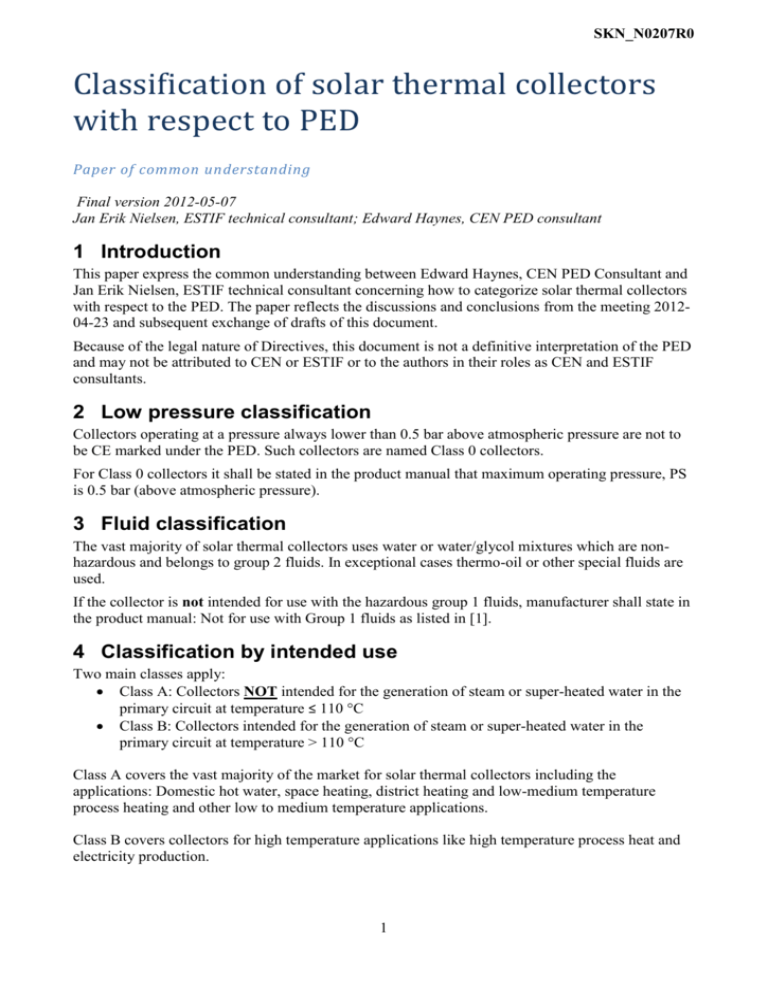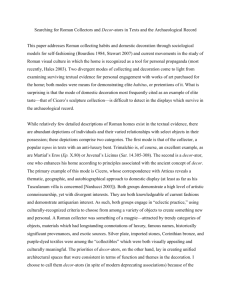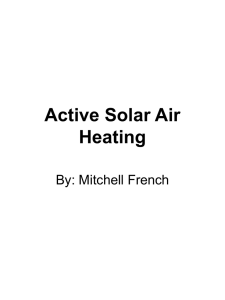Class B collectors - European Solar Thermal Industry Federation
advertisement

SKN_N0207R0 Classification of solar thermal collectors with respect to PED Paper of common understanding Final version 2012-05-07 Jan Erik Nielsen, ESTIF technical consultant; Edward Haynes, CEN PED consultant 1 Introduction This paper express the common understanding between Edward Haynes, CEN PED Consultant and Jan Erik Nielsen, ESTIF technical consultant concerning how to categorize solar thermal collectors with respect to the PED. The paper reflects the discussions and conclusions from the meeting 201204-23 and subsequent exchange of drafts of this document. Because of the legal nature of Directives, this document is not a definitive interpretation of the PED and may not be attributed to CEN or ESTIF or to the authors in their roles as CEN and ESTIF consultants. 2 Low pressure classification Collectors operating at a pressure always lower than 0.5 bar above atmospheric pressure are not to be CE marked under the PED. Such collectors are named Class 0 collectors. For Class 0 collectors it shall be stated in the product manual that maximum operating pressure, PS is 0.5 bar (above atmospheric pressure). 3 Fluid classification The vast majority of solar thermal collectors uses water or water/glycol mixtures which are nonhazardous and belongs to group 2 fluids. In exceptional cases thermo-oil or other special fluids are used. If the collector is not intended for use with the hazardous group 1 fluids, manufacturer shall state in the product manual: Not for use with Group 1 fluids as listed in [1]. 4 Classification by intended use Two main classes apply: Class A: Collectors NOT intended for the generation of steam or super-heated water in the primary circuit at temperature ≤ 110 °C Class B: Collectors intended for the generation of steam or super-heated water in the primary circuit at temperature > 110 °C Class A covers the vast majority of the market for solar thermal collectors including the applications: Domestic hot water, space heating, district heating and low-medium temperature process heating and other low to medium temperature applications. Class B covers collectors for high temperature applications like high temperature process heat and electricity production. 1 SKN_N0207R0 4.1 Class A: Collectors NOT intended for the generation of steam or super-heated water at temperature > 110 °C Class A collectors are subdivided into two sub classes: Class A1: Collectors considered as piping: Collectors with only one pipe all the way through the absorber are considered as piping, e.g. “serpentine collectors”. Class A2: Collectors considered as vessels: All other class A collectors not in class A1 (e.g. collectors with parallel tubing connected by common feeders/headers). 4.1.1 Categorization of Class A1 collectors (one-pipe / serpentine collectors) One-pipe collectors like serpentine collectors NOT intended for generation of steam or super-heated water in the primary circuit at temperature > 110 °C are categorized according to: PED Annex I, table 7 when used with fluids in group 2 (usual case of non-toxic, nonflammable fluids as water and water/glycol mixtures and other fluids not listed in REF 1) [Class A1f2] PED Annex I, table 6 when used with fluids in group 1 (exceptional case: toxic and/or flammable fluids as listed in REF 1) [Class A1f1]. 4.1.2 Categorization of Class A2 collectors (multi parallel pipe / harp type collectors) Non-serpentine collectors NOT intended for generation of steam or super-heated water in the primary circuit at temperature > 110 °C are categorized according to: PED Annex I, table 2 when used with fluids in group 2 (usual case of non-toxic, nonflammable fluids as water and water/glycol mixtures and other fluids not listed in REF 1) [Class A2f2] PED Annex I, table 1 when used with fluids in group 1 (exceptional case: toxic and/or flammable fluids as listed in REF 1) [Class A2f1] For Class A collectors it shall be stated in the product manual that: “The collector is NOT intended for generation of steam or super-heated water at temperature > 110 °C”. 4.2 Class B: Collectors intended for the generation of steam or super-heated water at temperature > 110 °C Collectors intended for generation of steam or super-heated water at temperature > 110 °C are always categorized with respect to attestation of conformity according to PED Annex I, table 5. For Class B collectors it shall be stated in the product manual that: “The collector is intended for generation of steam or super-heated water at temperature > 110 °C”. 5 CE marking of Class A1 collectors Class A1 is one-pipe /serpentine collectors NOT intended for generation of steam or superheated water in the primary circuit. Class A1 collectors are categorized according to table 1 or 2 for fluid group 1 and 2 respectively. Table 7 for group 2 fluids (non-hazardous fluids) is given below. This table will cover the vast majority of one-pipe / serpentine collectors. 2 SKN_N0207R0 The shaded area indicates area of typical class A1 collectors. It is seen from table 7 that [Class A1f2] collectors DN < 32 mm or PS*DN < 1 000 bar*mm are not to be CE marked. PS is maximum pressure stated by manufacturer. Given in bar (over atmospheric pressure). DN is maximum nominal diameter of the piping stated by manufacturer. Given in mm. For Group 1 fluids the similar table 6 is used - here the limit is more strict: DN = 25 is here the limit for CE marking. 6 CE marking of Class A2 collectors Class A2 is for multi-pipe /harp-type collectors NOT intended for generation of steam or superheated water in the primary circuit. Class A2 collectors are categorized according to table 1 or 3 SKN_N0207R0 2 for fluid group 1 and 2 respectively. Table 2 for group 2 fluids (non-hazardous fluids) is given below. This table will cover the vast majority of multi-pipe / harp-type collectors. The shaded area indicates area for typical class A2 collectors. It is seen from table two that only collectors with PS * V > 50 bar*litre shall have CE mark. No CEmarking in other cases when PS < 1000 bar. PS is maximum pressure stated by manufacturer. Given in bar (over atmospheric pressure). V is fluid volume content stated by manufacturer. Given in litres. PED guideline 2/23 [2] refers to such class A2 multi-pipe collectors. For Group 1 fluids the similar table 1 is used - here the limit is more strict: PS*V = 25 bar*litre is here the limit for CE marking. 4 SKN_N0207R0 7 Class B collectors Collectors intended for generation of steam or superheated water in the primary circuit are categorized according to table 5 shown below (used together with group 2 non-hazard fluids). This is collectors for high temperature applications like high temperature process heat and electricity production. The shaded area indicates area of typical class B collectors. All Class B collectors with V > 2 litres shall have CE mark. PS is maximum pressure stated by manufacturer. Given in bar (over atmospheric pressure). V is fluid volume content stated by manufacturer. Given in litres. 8 Product manual specifications: The following shall be specified in collector manual: Max. operating pressure, PS = 5 SKN_N0207R0 Volume content, V = DN for largest diameter, DN = Max. operating temperature, TS = Stagnation temperature at incident solar radiation of 1000 W/m² and ambient air temperature of 30°C, Tmax = A safety valve shall be installed in the collector loop to secure that the pressure in the collector is always lower than PS Not for use with Group 1 fluids as listed in [1] (if this is the case) 9 Specifications in standard It shall be clearly stated in a future collector standard harmonised to PED, that it only deals with the collector module and not with assemblies. 10 Others It will most probably not be possible to include an Annex Z related to PED in the ongoing revision of the standard (being now in public enquiry). A way to proceed could be to ask TC 312 to start work on a CEN TR or CEN TS dealing with PED requirements for solar thermal and systems and components (including collectors). Harmonised standards for solar thermal systems and components can be elaborated under the general Mandate M/071 CE marking related to PED can go together with the existing CEN KEYMARK certification scheme for solar collectors and systems - if the CE mark is at least as visible as the KEYMARK on the product and in accordance with PED ANNEX VI”. 6 SKN_N0207R0 11 Overview table for categorizing solar thermal collectors with respect to PED Main type Class 0 Class A1 Class A2 Class B “Low pressure collectors” (< ½ bar over atmosphere) “Collectors NOT intended for generation of steam or super heated water in the primary circuit” “Collectors intended for generation of steam or super heated water in the primary circuit” Sub type One-pipe / serpentine collectors Multi-pipe / harp type collectors Table to be used for categorization Group 1 fluids Group 2 fluids CE mark when Group 1 fluids Group 2 fluids Never PED, Annex 1, PED, Annex 1, table 6 table 7 PED, Annex 1, PED, Annex 1, table 1 table 2 PED, Annex 1, table 5 DN > 25 mm DN > 32 mm PS*V > PS*V > 25 bar*litres 50 bar*litres V > 2 litres The most common cases covering the vast majority of the market (domestic hot water, space heating, district heating, low temperature process heating, etc.) are indicated with bold. 12 References [1]: DIRECTIVE 97/23/EC OF THE EUROPEAN PARLIAMENT AND OF THE COUNCIL, Article 9, § 2.1:Group 1 comprises dangerous fluids. A dangerous fluid is a substance or preparation covered by the definitions in Article 2 (2) of Council Directive 67/548/EEC of 27 June 1967 on the approximation of the laws, regulations and administrative provisions relating to the classification, packaging and labelling of dangerous substances(OJ No 196, 16. 8. 1967, p. 1. Directive as last amended by Commission Directive 94/69/EC (OJ No L 381, 31. 12. 1994, p. 1). Group 1 comprises fluids defined as: - explosive, - extremely flammable, - highly flammable, - flammable (where the maximum allowable temperature is above flashpoint), - very toxic, - toxic, - oxidizing. 7 SKN_N0207R0 [2]: PED Guideline 2/23; (http://ec.europa.eu/enterprise/sectors/pressure-and-gas/documents/ped/guidelines/index_en.htm) 8 SKN_N0207R0 Annex: Flow chart for PED categorization of solar collectors 9






